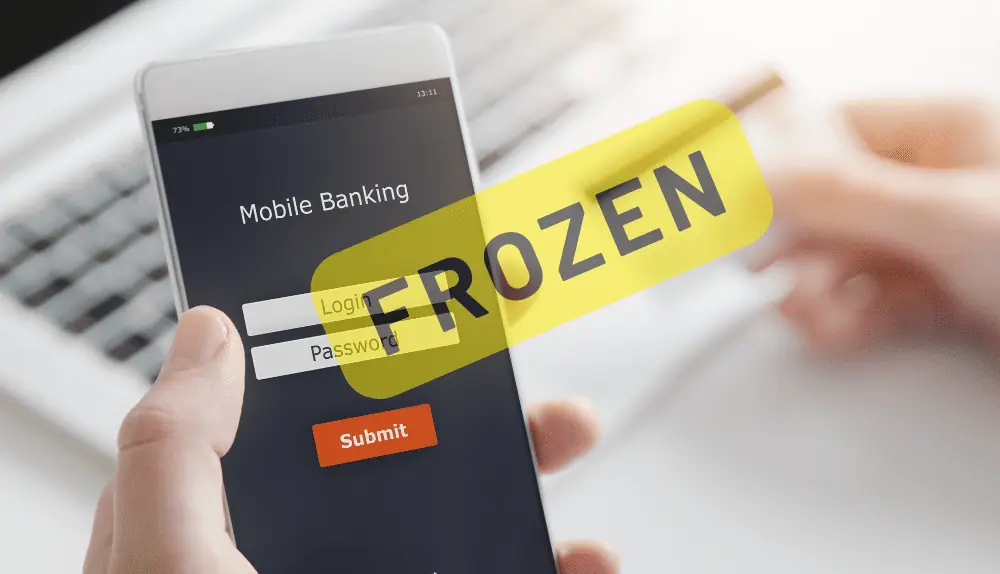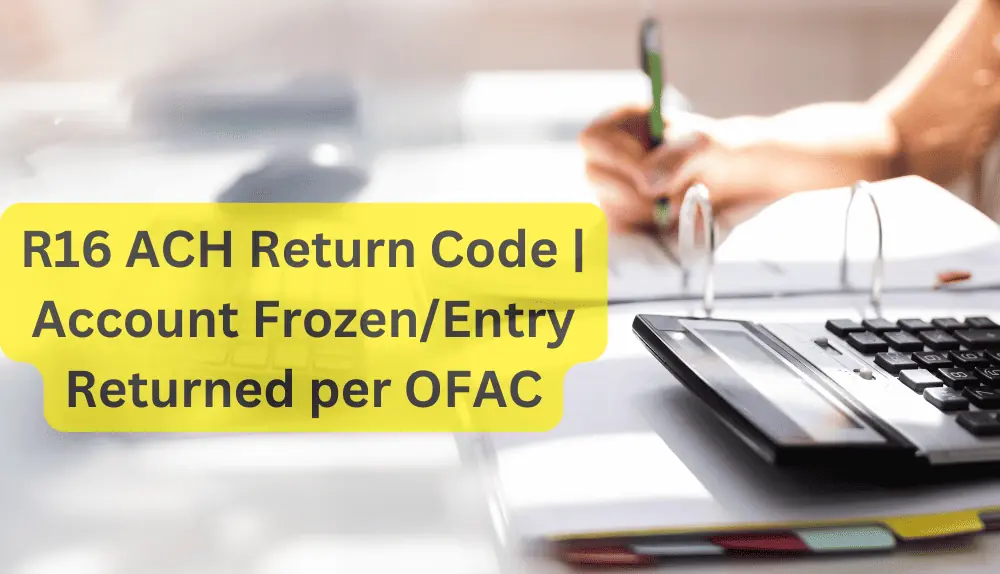In the fast-paced world of financial transactions, where every digit and decision counts, the banking industry relies on a complex network of codes to ensure seamless and secure operations. Among these, the R16 ACH Return Code stands as a sentinel, guarding against potential risks and maintaining the integrity of the system.
Yet, hidden within its seemingly unassuming digits lies a tale of caution and control, as it unfurls the mysterious dance between an “Account Frozen” status and the enigmatic “Entry Returned per OFAC.” Join us as we venture into the intriguing realm of financial regulations, where the R16 ACH Return Code takes center stage, unraveling the delicate balance between compliance and vigilance in the battle against illicit activities.
Explore with us the implications, intricacies, and significance of this code as we delve into the heart of financial security and peace of mind.
What Does R16 ACH Return Code Mean?
ACH Return Code R16 indicates that the attempted transaction has encountered a significant obstacle due to the receiver’s account being frozen for various reasons. When a payment request is sent via the ACH system, it initially appears as a temporary loan from your bank, resulting in the funds being deposited into your account. However, once the request undergoes processing and the interbank transfer is initiated, if the customer’s bank (the RDFI) is unable to fulfill the request, the funds will be returned, and the amount will be deducted from your account a few days later.

The underlying cause of ACH return code R16 involves the account holder facing legal action or restrictions imposed by the RDFI. This could be due to a range of scenarios, including a tax lien, identity theft, or a failure to comply with a legal settlement payment. Such actions prompt the bank to freeze the account, preventing any further transactions until the issue is resolved or legal obligations are met.
Understanding ACH return code R16 is crucial for businesses and financial institutions to comprehend the reasons behind transaction failures and take appropriate actions. It underscores the significance of adhering to legal and regulatory requirements to ensure smooth and secure financial transactions, safeguarding both the account holder’s interests and the integrity of the financial system.
Reasons R16 ACH Return Code Can Occur
The ACH (Automated Clearing House) system plays a crucial role in facilitating electronic fund transfers, allowing businesses and individuals to process various financial transactions efficiently. However, there are instances when an ACH transaction encounters obstacles, leading to return codes that indicate the failure of the payment. One such return code is ACH R16, which can occur due to various reasons related to the receiver’s account. Let’s explore some of the common reasons why an ACH R16 return code can occur:
Account Frozen
A primary reason for an ACH R16 return code is that the receiver’s bank has frozen their account. Account freezes may happen for several reasons, including suspicious or fraudulent activity, compliance issues, or legal obligations. When an account is frozen, all transactions, including ACH transfers, are halted until the situation is resolved.
Insufficient Funds
Insufficient funds in the receiver’s account is a frequent cause of ACH R16 returns. If the account balance is not enough to cover the amount of the ACH transaction, the receiver’s bank will reject the payment request.
Invalid Account Number
Another common reason for ACH R16 return codes is an invalid or incorrect account number. If the provided account number does not match any existing account, the receiving bank will be unable to process the payment.
Account Closed
If the receiver has closed their account before the ACH transaction is processed, the payment will be returned, and the funds will not be transferred.
RDFI Did Not Participate
The Receiving Depository Financial Institution (RDFI) may not participate in the ACH network or may lack the capability to process ACH transactions. In such cases, the ACH payment will be returned with the R16 return code.
OFAC Compliance
The Office of Foreign Assets Control (OFAC) enforces economic sanctions against certain individuals, entities, and countries. If the receiver’s name matches one on the OFAC’s list of sanctioned parties, their account may be frozen to prevent any further financial activity.
Death of Account Holder
In the unfortunate event of the account holder’s death, their bank may freeze the account until the appropriate legal procedures are followed, leading to an ACH R16 return.
Incorrect Routing Number
If the routing number provided in the ACH transaction is incorrect or invalid, the payment will not be successfully processed, and an R16 return code will be triggered.
It is crucial for businesses and financial institutions to understand the reasons behind ACH R16 return codes to ensure smooth and error-free financial transactions. When such returns occur, it may result in delays, extra costs, and possible dissatisfied customers. Therefore, businesses need to verify account information and ensure that they comply with all legal and regulatory requirements before initiating ACH transactions.
To minimize the occurrence of ACH R16 return codes, businesses can implement robust verification processes, use reliable and up-to-date account information, and maintain clear communication channels with customers regarding payment status and potential issues. Additionally, staying informed about changes in financial regulations and OFAC lists can help businesses avoid frozen accounts and potential legal complications.
Overall, ACH R16 return codes serve as essential indicators of potential issues with ACH transactions. By understanding the various reasons behind these return codes and implementing appropriate measures, businesses can optimize their payment processes, mitigate risks, and maintain efficient financial operations.
Solutions to Fix R16 ACH Return Code
Fixing ACH R16 Return Code requires identifying the specific reason for the return and implementing appropriate solutions to address the underlying issue. Below are some common solutions to fix ACH R16 Return Code:

Resolve Account Freeze Issue
If the ACH R16 return is due to an account freeze, the account holder or the business initiating the payment needs to contact the receiving bank to understand the reason for the freeze. Once the cause is determined, appropriate actions, such as providing required documentation or resolving compliance issues, can be taken to lift the freeze and enable successful ACH transactions.
Verify Sufficient Funds
To avoid ACH R16 returns due to insufficient funds, businesses should verify that the receiver’s account has enough funds to cover the transaction before initiating the payment. Communicating with customers and ensuring timely payments can also help prevent such occurrences.
Confirm Account Number Accuracy
To avoid ACH R16 return codes resulting from incorrect or invalid account numbers, businesses must double-check the provided account information before processing the payment. Using automated account validation systems can help ensure accuracy and reduce errors.
Update Closed Accounts
If an ACH R16 return is due to the receiver’s account being closed, businesses should promptly update their records and refrain from attempting any further transactions with the closed account.
Check RDFI Participation
Before initiating an ACH transaction, businesses should verify whether the receiver’s bank is part of the ACH network and capable of processing ACH payments. If the RDFI does not participate in ACH transactions, alternative payment methods should be used.
OFAC Compliance Review
To avoid ACH R16 return codes triggered by OFAC compliance issues, businesses must conduct regular reviews of their customers’ names against the OFAC list. Implementing robust compliance procedures and screening tools can help identify potential risks beforehand.
Deceased Account Holder Handling
In the case of an ACH R16 return due to the death of the account holder, businesses should follow appropriate legal procedures to address the situation. This may involve freezing the account until the necessary documentation and legal requirements are met.
Validate Routing Numbers
To prevent ACH R16 returns caused by incorrect routing numbers, businesses should use reliable sources to verify routing numbers before initiating ACH transactions.
Customer Communication
Maintaining open and clear communication channels with customers can help prevent ACH R16 returns. Promptly notifying customers of potential issues with their accounts or payments can lead to timely resolution and successful transactions.
Continuous Monitoring and Improvement
Regularly monitoring ACH transaction outcomes and analyzing return codes can help businesses identify recurring issues. By continuously improving their payment processes and addressing potential pitfalls, businesses can reduce ACH R16 return occurrences over time.
By implementing these solutions and maintaining a proactive approach to ACH transactions, businesses can reduce the frequency of ACH R16 return codes, enhance customer satisfaction, and ensure smooth financial operations.
Final Words
In conclusion, understanding the reasons behind ACH Return Code R16 is essential for businesses and financial institutions to ensure seamless and secure electronic fund transfers. The occurrences of ACH R16 return codes can be attributed to a range of factors, including frozen accounts, insufficient funds, invalid account numbers, compliance issues, and more. However, armed with this knowledge, businesses can implement appropriate solutions to address each specific issue, thereby reducing the occurrence of ACH R16 return codes and optimizing their payment processes.
Vigilant account verification, communication with customers, compliance reviews, and continuous process improvement are key components of a successful strategy to mitigate ACH R16 return incidents. By adhering to these best practices, businesses can safeguard their financial transactions, enhance customer experiences, and maintain the integrity of the ACH system as a reliable and efficient method of transferring funds. Ultimately, by actively addressing ACH R16 return code occurrences, businesses can foster trust and confidence among customers, establishing themselves as trustworthy partners in the ever-evolving landscape of electronic payments.
Frequently Asked Questions (FAQs)
What does ACH Return Code R16 signify?
ACH Return Code R16 indicates that the attempted ACH transaction has been rejected because the receiver’s account is frozen or restricted. It may also occur when the transaction violates the Office of Foreign Assets Control (OFAC) regulations.
Why would a receiver’s account be frozen?
An account may be frozen for various reasons, including suspected fraudulent activity, compliance issues, legal obligations, or if the receiver’s name matches one on the OFAC’s list of sanctioned entities.
What should I do if I receive an ACH R16 return code?
If you encounter an ACH R16 return code, you should first contact your bank to inquire about the specific reason for the return. Depending on the cause, you may need to provide additional documentation, resolve compliance issues, or take appropriate legal actions to address the freeze.
How can businesses prevent ACH R16 returns due to insufficient funds?
To avoid ACH R16 returns caused by insufficient funds, businesses should verify the receiver’s account balance before initiating the transaction. Regular communication with customers and timely payment requests can also help prevent such occurrences.
What can businesses do to ensure the accuracy of account information?
Businesses can implement automated account validation systems to verify the accuracy of account information, including account numbers and routing numbers, before processing ACH transactions.
Is there any way to appeal an ACH R16 return?
While ACH R16 returns are typically initiated by the receiver’s bank, you can inquire with your bank about the possibility of appealing the return if you believe it was made in error or due to a misunderstanding.

